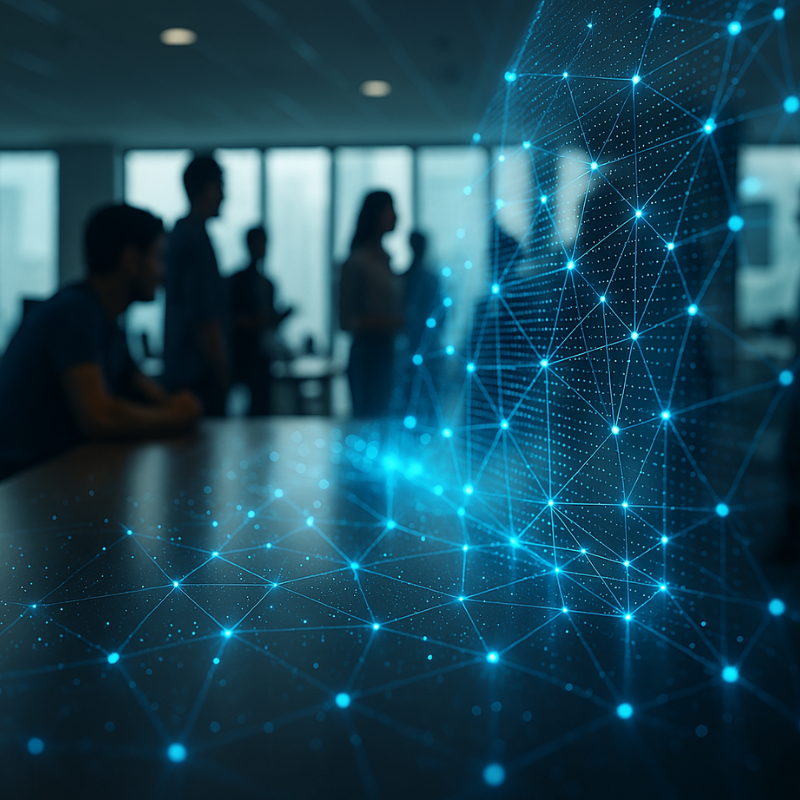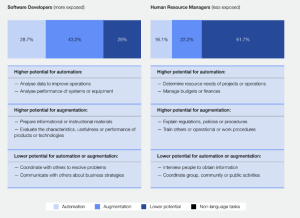Ways of Work

Key Takeaway:
Workplace culture is evolving as employees prioritize work-life balance over traditional job incentives, while AI integration raises concerns about job security, stress, and transparency. The rise of human-AI collaboration is reshaping roles, requiring leaders to ensure responsible AI adoption that fosters engagement, innovation, and trust. Businesses that embrace AI as a skill amplifier while maintaining clear communication and human-centered leadership will drive productivity and future-proof their workforce in an increasingly AI-driven world.
Trend Type: Social & Business
Sub-trends: Work: Human or Machine?, Humanoids Change Work Dynamics, Talent Shifts, GenAI Job Augmentation & Automation, GenAI Uncertainty in the Workforce, Learning Loop
Workplace Culture and Employee Experience
Workplace culture, employee engagement, and leadership approaches are evolving in response to economic pressures, technological advancements, and shifting employee expectations. However, these changes are not without challenges.
First, with what Accenture Life Trends’ 2024 report highlights as an “employee experience recession” (phrase first coined by Forrester that has picked up steam!) where employee engagement fell globally. As in last year’s trends report, employees continue to prioritize work-life balance (52%) over salary (48%) and job security (39%) – refer to Balancing Reality and Good Enough Life, for more.
Second, workplace technology, intended to enhance productivity, is often adding complexity, a phenomenon called “technostress” (Pothuganti Kumar, 2024). In AI, Accenture Life Trends’ 2024 report found that 60% of global employees fear this technology will increase stress and burnout, yet only 37% of leaders share this concern. Workers are particularly uneasy about AI’s role in hiring, performance evaluations, and automation, fearing they will be treated like machines. Resistance is growing as employees suspect AI could replace jobs rather than augment them.
Job Augmentation vs. Job Automation
On the plus side though, while AI adoption raises job displacement concerns, research suggests job augmentation (use of GenAI to partially perform tasks in such a way that technology effectively supports or enhances human capabilities through human-machine collaboration) is a more likely outcome than full automation (use of GenAI to fully perform tasks that were previously performed by humans in a given occupation). While a wide range of tasks may be fully automated by GenAI, research to date (e.g PWC, WEF, McKinsey) frequently indicates that very few entire job roles will be eliminated. In fact, similar ways to earlier industrial transformations, both job automation and job augmentation may be expected to lead to additional job creation – both directly, creating wholly new jobs in various fields. AI is expected to enhance human work by handling routine tasks, allowing employees to focus on creative and strategic aspects of their roles.
This shift is enhanced by the technology serving as a learning partner rather than merely an efficiency tool, as it creates a feedback loop—the more employees use AI, the smarter it becomes, ultimately enhancing human capabilities. Brandwatch’s survey found that businesses prioritizing AI for skill enhancement and job augmentation will see greater success than those relying solely on automation. Companies that integrate AI into workflows without eliminating the human touch will benefit from a more engaged, innovative workforce.
To be more specific, AI is driving new job opportunities in areas like AI governance, human-machine collaboration, and data analytics. Some jobs are more exposed than others, in regards of automation. The WEF provides two examples, with different exposures:

Source: WEF - Generative AI for Job Augmentation and Workforce Productivity, 2024
It also outlines four possible futures for AI in the workplace:
- High Hopes – AI leads to widespread augmentation and productivity gains.
- Broken Promises – AI fails to deliver on its promised benefits.
- Lost Opportunities – AI adoption is slow, leading to inefficiencies.
- Shifting Gears – AI evolves unpredictably, requiring ongoing adaptation
These scenarios highlight the uncertainty surrounding AI’s long-term impact. Amara’s Law suggests that while people often overestimate short-term technological impact, they underestimate long-term effects. The real question is how organizations will scale AI adoption responsibly to ensure productivity gains without sacrificing employee well-being.
Use Cases
Work: Human or machine? Zoom founder Eric Yuan has big ambitions in enterprise software, including letting your AI-powered ‘digital twins’ attend meetings for you. In an interview with Verge, in June 2024, Yuan said he wants people to have their own personal AI “digital twin” to attend meetings and write emails for them so that they can “go to the beach” instead. AI clones could help shorten the workweek to three or four days, Yuan added.
Learning Loop: Niraj Nagrani, VP and GM for Consumer and Supplier Technologies at Wayfair, shares how the global home furnishings giant is partnering with Google Cloud to supercharge its technology transformation. Watch how Wayfair is using AI and ML solutions to unlock new levels of developer productivity and accelerate its migration to a modern, cloud-native architecture. For instance, Wayfair’s developers used AI coding assistants to speed up their work by 55%, allowing them to focus on more strategic tasks.
GenAI Job Augmentation & Automation: Toyota unveiled a generative artificial intelligence (AI) technique to amplify vehicle designers. Currently, designers can leverage publicly available text-to-image generative AI tools as an early step in their creative process. With this new technique, designers can add initial design sketches and engineering constraints into this process, cutting down the iterations needed to reconcile design and engineering considerations.
Use Cases
Sub-Trend Sources
Work: Human or Machine?: Accenture Life Trends
Humanoids Change Work Dynamics: Forbes Tech Predictions
Talent Shifts: Forbes Tech Predictions
GenAI Job Augmentation & Automation: WEF - Generative AI for Job Augmentation and Workforce Productivity, McKinsey Year in Review, PWC AI Business Predictions.
GenAI Uncertainty in the Workforce: WEF - Generative AI for Job Augmentation and Workforce Productivity
Learning Loop: Accenture Tech Vision
What to Read Next
Good Enough Life
From Aspirational To Sufficient Young people are abandoning broken milestones and rewriting the rules of adulthood. According to Deloitte’s 2024 Global Millennial Survey, 64% of Gen Z and Millennials believe[...]
Balancing Reality
Rebalancing Digital and Physical Life This trend has been unfolding since the Covid era, when people rediscovered nature, in-person socialization, and tangible connections. In sum, as digital saturation grows, people[...]
Sameness
Sameness in the Algorithmic Age In a world where everything is optimized, everything starts to look the same. The rise of algorithmically driven platforms has accelerated the convergence of aesthetics,[...]
What to Read Next
Good Enough Life
From Aspirational To Sufficient Young people are abandoning broken milestones and rewriting the rules of adulthood. According to Deloitte’s 2024 Global Millennial Survey, 64% of[...]
Balancing Reality
Rebalancing Digital and Physical Life This trend has been unfolding since the Covid era, when people rediscovered nature, in-person socialization, and tangible connections. In sum,[...]
Sameness
Sameness in the Algorithmic Age In a world where everything is optimized, everything starts to look the same. The rise of algorithmically driven platforms has[...]


